26th August, 2025
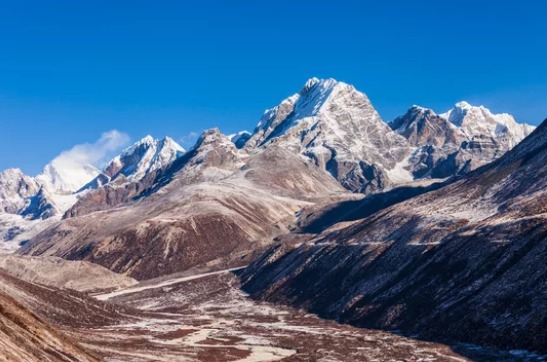
Jun 01, 2024
Lobuche Peak Climbing In December
- Winter Climbing on Lobuche Peak: Challenges and Rewards
- December Weather Conditions on Lobuche Peak
- Crampons and Ice Axe Techniques for Winter Climbing
- Avalanche Risk Assessment in December
- Cold Weather Gear and Clothing Essentials
- Lobuche East vs. Lobuche West: Winter Route Comparison
- Permit Requirements and Regulations for December Climbs
- Hiring a Guide or Joining a Guided Expedition in December
- Physical Conditioning for Winter High-Altitude Climbing
- Crevasse Rescue Techniques in Deep Snow Conditions
- Winter Camping on Lobuche Peak: Tips and Strategies
- Staying Warm and Dry in Extreme Cold Conditions
- Dealing with Frostbite and Hypothermia on the Mountain
- Emergency Response Planning for Winter Climbing Accidents
- Communication Strategies in Remote Winter Environments
- Lobuche Peak Climbing Itinerary for December: Day-by-Day Breakdown
- Packing Essentials for Winter Climbing on Lobuche Peak
- Winter Navigation Techniques: GPS, Maps, and Compass Use
- Environmental Impact of Winter Climbing on Lobuche Peak Ecosystems
- Conclusion: Tips for a Successful Lobuche Peak Climb in December
- Lobuche Peak Climbing Packages
Climbing Lobuche Peak in December presents an exhilarating challenge amidst the stunning winter landscape of the Everest region in Nepal. Standing at 6,119 meters (20,075 feet), Lobuche Peak is renowned for its technical ascent and panoramic views of Everest, Lhotse, and Nuptse.
December marks the onset of winter in the Himalayas, bringing colder temperatures and occasional snowfall. While the weather can be unpredictable with the possibility of storms and high winds, December often offers clear skies and excellent visibility, ideal for climbing. However, climbers must prepare for sub-zero temperatures, especially at higher altitudes, requiring proper cold-weather gear such as down jackets, insulated pants, and sturdy mountaineering boots with crampons.
The journey to Lobuche Peak begins with a thrilling flight from Kathmandu to Lukla, followed by a trek through the Khumbu Valley. The trail passes through vibrant Sherpa villages like Namche Bazaar and Tengboche, adorned with Buddhist monasteries and prayer flags. Accommodation options range from cozy tea houses to comfortable lodges, providing essential amenities amidst the tranquil mountain environment.
Climbing Lobuche Peak in December demands technical proficiency in mountaineering skills such as ice climbing, rope handling, and glacier navigation. The ascent involves negotiating steep ice and snow slopes, traversing crevasses, and acclimatizing at key points like Dingboche and Lobuche Base Camp. Climbers must maintain physical fitness and mental resilience to overcome challenges posed by high altitude and variable weather conditions.
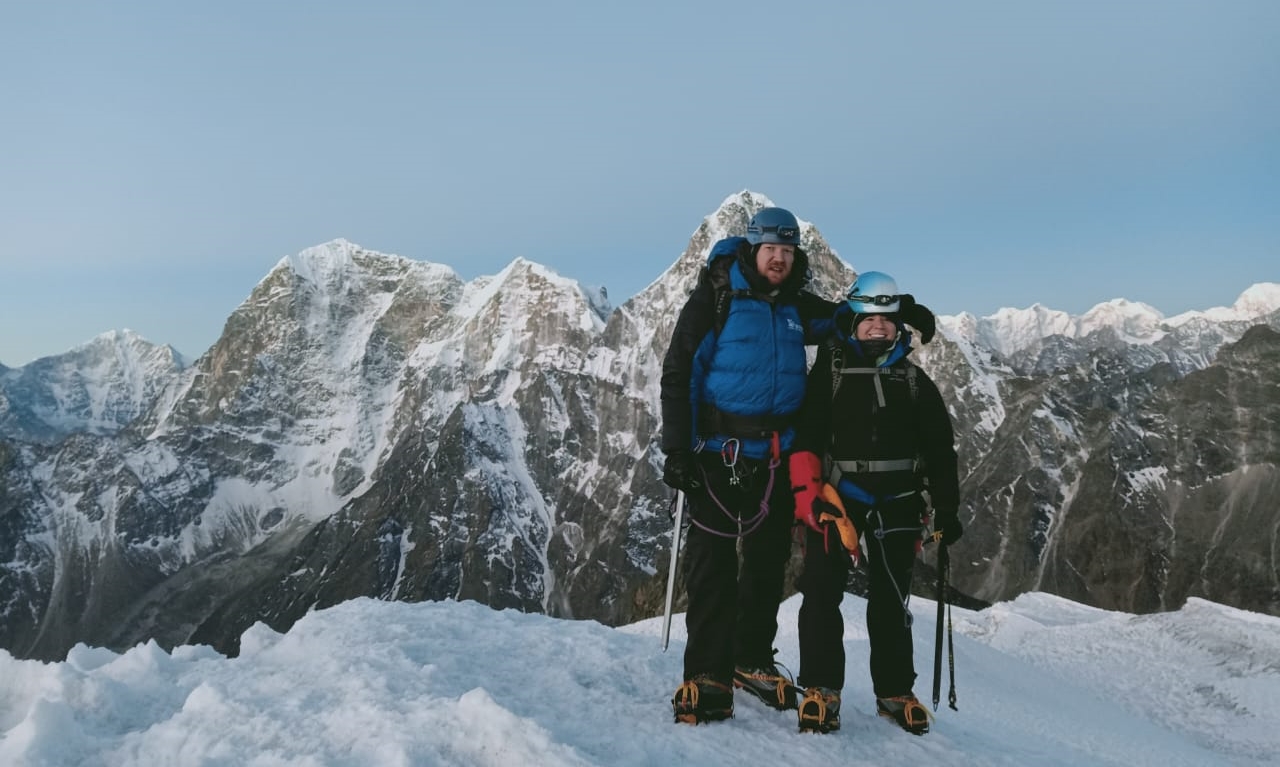
LOBUCHE PEAK CLIMBING
Lobuche East (6,119m/20,075ft), set in Nepal's stunning Khumbu on the Nepalese side of Everest.The best time to go trekking in Nepal is in Autumn (September-November) and in...
Summiting Lobuche Peak in December rewards climbers with breathtaking views from the summit, offering a bird's-eye perspective of the Himalayan giants. The panoramic vista includes Everest, the world's highest peak, along with neighboring summits bathed in the soft glow of winter sunlight. Cultural interactions with Sherpa communities enrich the experience, providing insights into local traditions and warm hospitality amidst the cold mountain environment.
Climbing Lobuche Peak in December combines the thrill of adventure with the serenity of Nepal's high Himalayas. Despite the challenges posed by winter conditions, December offers a quieter and more intimate climbing experience, allowing climbers to forge unforgettable memories amidst the pristine beauty of the Everest region. Whether driven by the quest for personal achievement or the desire to connect with nature and culture, Lobuche Peak in December promises an enriching journey that celebrates both the spirit of exploration and the grandeur of the world's highest mountains.
Winter Climbing on Lobuche Peak: Challenges and Rewards
Winter climbing on Lobuche Peak presents mountaineers with a unique set of challenges and rewards amidst the pristine beauty of Nepal's Khumbu region. Standing at 6,119 meters (20,075 feet), Lobuche Peak offers a technical ascent that tests climbers' skills and endurance against the backdrop of snowy landscapes and clear, crisp winter skies. Challenges include navigating icy slopes, enduring sub-zero temperatures, and mitigating the risks of avalanches and frostbite. However, the winter season also provides quieter trails and stunning views of Everest and neighboring peaks, making it a rewarding experience for those seeking adventure and breathtaking vistas in a tranquil mountain setting. Climbers must balance the thrill of summiting with careful preparation and adherence to safety protocols to ensure a successful and memorable winter climb on Lobuche Peak.
December Weather Conditions on Lobuche Peak
December brings the onset of winter weather to Lobuche Peak and the surrounding Everest region, characterized by cold temperatures and occasional snowfall. Daytime temperatures at lower elevations can range from -5°C to 5°C (23°F to 41°F), while temperatures at higher altitudes, including Lobuche Base Camp and High Camp, often drop well below freezing. Clear skies are typical during early December, offering excellent visibility for climbing, though weather patterns can be unpredictable with the potential for sudden storms and high winds. Climbers should prepare for varying conditions by packing adequate cold-weather gear, including insulated jackets, waterproof gloves, and sturdy boots with crampons for traction on icy surfaces. Monitoring weather forecasts from reliable sources is essential for planning safe ascent and descent routes on Lobuche Peak during December.
Crampons and Ice Axe Techniques for Winter Climbing
Crampons and ice axe techniques are essential skills for winter climbing on Lobuche Peak, where icy and snowy terrain demand precise footwork and secure anchoring. Crampons, fitted to mountaineering boots, feature metal spikes that provide traction on steep slopes and icy surfaces. Climbers utilize front-pointing techniques to ascend and descend safely, maintaining balance and stability with each step. Ice axes serve multiple purposes, including self-arrest in case of slips or falls and creating secure anchor points for rope teams during glacier crossings. Techniques such as the French technique and German technique vary in grip and leverage, allowing climbers to adapt to different snow and ice conditions encountered on Lobuche Peak. Mastery of crampon and ice axe techniques is crucial for navigating technical terrain and ensuring safe progression throughout the winter climb, enhancing climbers' confidence and efficiency in challenging Himalayan conditions.

LOBUCHE PEAK SUMMIT RETURN BY HELICOPTER
A real climbing adventure that will leave you stunned at the beauty of the Himalayan Mountains. The Lobuche Peak Climbing expedition in the spectacular Khumbu region of Nepal has been ranked by Lonely...
Avalanche Risk Assessment in December
Avalanche risk assessment is a critical aspect of winter climbing on Lobuche Peak, where snow accumulation and changing weather conditions can increase the likelihood of avalanches. Factors contributing to avalanche risk include steep terrain, recent snowfall, wind loading, and temperature fluctuations. Climbers assess slope angles and terrain features for signs of instability, such as recent avalanches, cracking or collapsing snow layers, and visible wind patterns. Monitoring weather forecasts and snowpack stability through snow pits and stability tests informs decision-making on route selection and timing for safe ascent and descent. Implementing mitigation strategies, such as traveling early in the day to avoid solar heating, maintaining safe distances between team members, and carrying avalanche rescue equipment, enhances safety in avalanche-prone areas of Lobuche Peak during December. Climbers should prioritize avalanche awareness and preparedness to minimize risks and ensure a successful and safe winter climbing experience in the Himalayas.
Cold Weather Gear and Clothing Essentials
Cold weather gear and clothing essentials are indispensable for winter climbing on Lobuche Peak, where temperatures can plummet and conditions can change rapidly. Layering is key to regulating body temperature and managing moisture, starting with a base layer of moisture-wicking fabric to keep skin dry and insulated mid-layers for warmth. A down or synthetic insulated jacket provides additional warmth during rest breaks and summit attempts, while waterproof and windproof outer layers protect against snow, wind, and freezing temperatures. Accessories such as insulated gloves, a balaclava or neck gaiter, and thermal socks with mountaineering boots equipped with crampons ensure comfort and protection in challenging winter conditions. Sunglasses with UV protection and a sun hat shield against glare and snow blindness from the sun's reflection on snowy surfaces. Packing spare clothing and emergency shelter materials in a waterproof backpack prepares climbers for unexpected weather changes and ensures readiness for the rigors of winter climbing on Lobuche Peak.

LOBUCHE PEAK EXPEDITION 14 DAYS
The Lobuche Peak Expedition is a 14-day trekking adventure that takes you to the heart of the Khumbu region in Nepal. It is a popular trekking peak in the Himalayas, with stunning views of the surroun...
Lobuche East vs. Lobuche West: Winter Route Comparison
Lobuche East and Lobuche West are two distinct peaks in the Everest region, each offering unique challenges and rewards for winter climbers. Lobuche East, standing at 6,119 meters (20,075 feet), is renowned for its technically demanding climb, featuring steep ice and rock faces that require advanced mountaineering skills. The ascent typically involves navigating crevasses and traversing glacier terrain, with panoramic views of Everest, Lhotse, and Nuptse from the summit. In contrast, Lobuche West, at 6,145 meters (20,161 feet), offers a slightly higher elevation and a less technically challenging route, making it accessible to climbers with moderate experience. The climb to Lobuche West involves ascending snow slopes and negotiating crevasses, with breathtaking views of the Khumbu Glacier and surrounding peaks.
Choosing between Lobuche East and Lobuche West depends on climbers' skill levels, objectives, and preferences for technical difficulty versus altitude gain. Both peaks provide memorable winter climbing experiences amidst the serene beauty of the Himalayas, offering opportunities for personal achievement and exploration in Nepal's high-altitude environment.
Permit Requirements and Regulations for December Climbs
Permit requirements and regulations for winter climbs on Lobuche Peak and surrounding peaks in the Everest region are essential for ensuring safety and environmental conservation. Climbers must obtain a climbing permit from the Nepal Mountaineering Association (NMA) or the Ministry of Tourism, Culture, and Civil Aviation (MoTCCA), depending on the peak's classification and location. Permits specify climbing dates, route details, and required fees, contributing to responsible tourism management and support for local communities.
Environmental regulations aim to minimize impact on fragile Himalayan ecosystems, including waste management practices and adherence to Leave No Trace principles. Climbers should carry out all non-biodegradable waste and adhere to designated climbing routes to preserve natural habitats and cultural heritage sites. Conservation efforts are crucial for maintaining the pristine beauty and biodiversity of the Everest region, ensuring future generations can enjoy the Himalayan wilderness.
Hiring a Guide or Joining a Guided Expedition in December
Hiring a qualified guide or joining a guided expedition in December enhances safety and enhances the overall climbing experience on Lobuche Peak. Professional guides possess extensive knowledge of local terrain, weather patterns, and emergency procedures, providing valuable support and guidance throughout the climb. Guides facilitate acclimatization stops, route planning, and navigation through challenging terrain, optimizing climbers' chances for a successful summit bid.
Guided expeditions offer logistical support, including transportation, accommodation, and meals, allowing climbers to focus on physical preparation and enjoyment of the climb. Experienced guides also share insights into Sherpa culture, mountaineering history, and local flora and fauna, enriching the cultural and educational aspects of the expedition. Safety protocols, such as crevasse rescue techniques and emergency response, are prioritized during guided climbs to mitigate risks and ensure climbers' well-being in the high-altitude environment of the Himalayas.
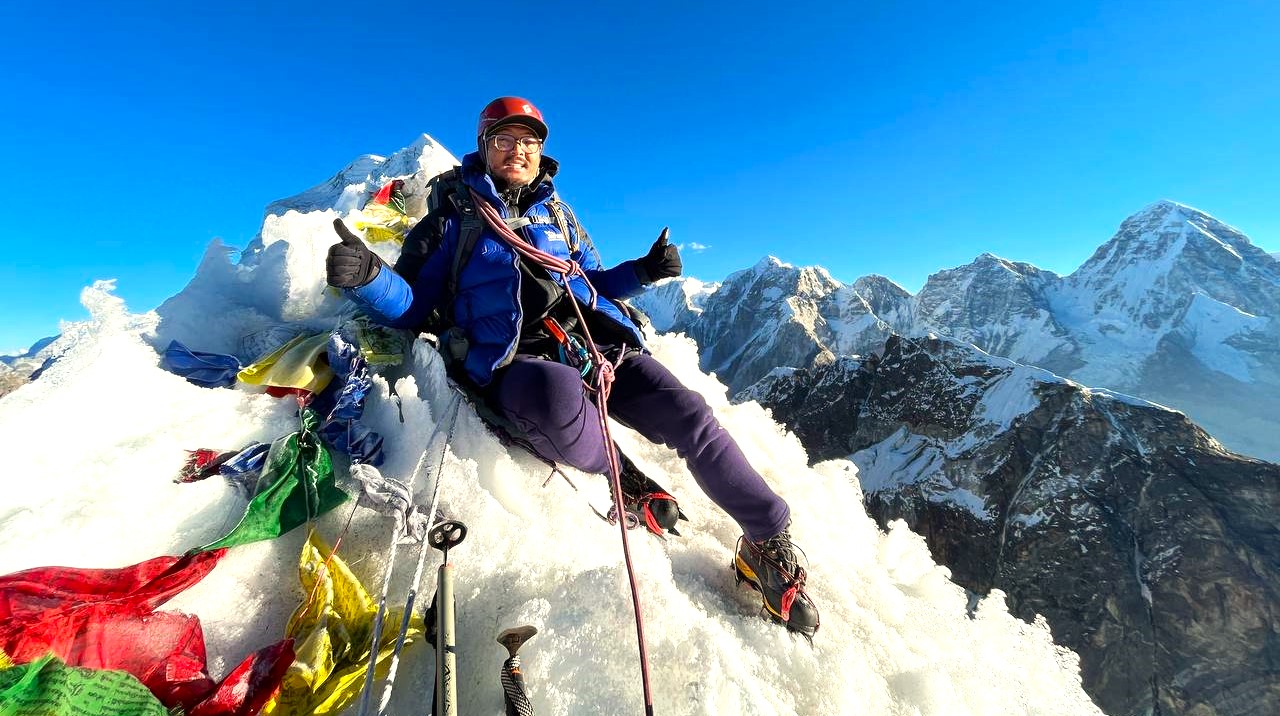
LOBUCHE PEAK EXPEDITION 15 DAYS
Lobuche Peak Expedition is a thrilling adventure that takes you to the heart of the Khumbu region in Nepal. The peak stands at an altitude of 6,119 meters and offers stunning views of the surrounding...
Physical Conditioning for Winter High-Altitude Climbing
Physical conditioning is crucial for preparing climbers for the demands of winter high-altitude climbing on peaks like Lobuche. Training focuses on cardiovascular endurance, strength, and flexibility to withstand prolonged periods of exertion at high altitudes. Aerobic activities such as hiking, running, and cycling improve lung capacity and oxygen utilization, essential for adapting to reduced oxygen levels at higher elevations.
Strength training targets core muscles, legs, and upper body for carrying heavy packs, navigating uneven terrain, and using mountaineering equipment effectively. Flexibility exercises enhance joint mobility and reduce the risk of muscle strains during ascents and descents. Altitude training simulates high-altitude conditions through controlled exposure, promoting acclimatization and enhancing physical performance at extreme elevations.
Proper nutrition and hydration are equally important for maintaining energy levels and supporting muscle recovery during winter climbs. A balanced diet rich in carbohydrates, proteins, and healthy fats fuels prolonged exertion and aids in acclimatization to high altitudes. Adequate hydration with water and electrolyte-rich fluids prevents dehydration and altitude-related illnesses, ensuring climbers remain strong and resilient throughout the challenging conditions of winter climbing on Lobuche Peak.
Crevasse Rescue Techniques in Deep Snow Conditions
Crevasse rescue techniques are essential skills for navigating glacier terrain and mitigating risks during winter climbs on Lobuche Peak. Deep snow conditions increase the likelihood of crevasse falls, requiring climbers to be proficient in self-rescue and team rescue methods. Self-arrest techniques using an ice axe enable climbers to stop a fall and secure themselves on steep slopes or icy surfaces.
Team rescue techniques involve using ropes, harnesses, and pulley systems to extract a fallen climber from a crevasse safely. Anchoring systems and snow anchors provide secure points for setting up rescue operations and establishing communication between team members. Practice drills and scenario-based training prepare climbers to respond effectively to emergencies, ensuring rapid and coordinated rescue efforts in remote mountain environments.
Maintaining situational awareness and adhering to safety protocols, such as rope team travel and route markers, minimize the risk of crevasse accidents during winter climbs. Climbers should regularly review and update their crevasse rescue skills to remain prepared for unexpected challenges and emergencies on Lobuche Peak and other glaciated terrain in the Himalayas.
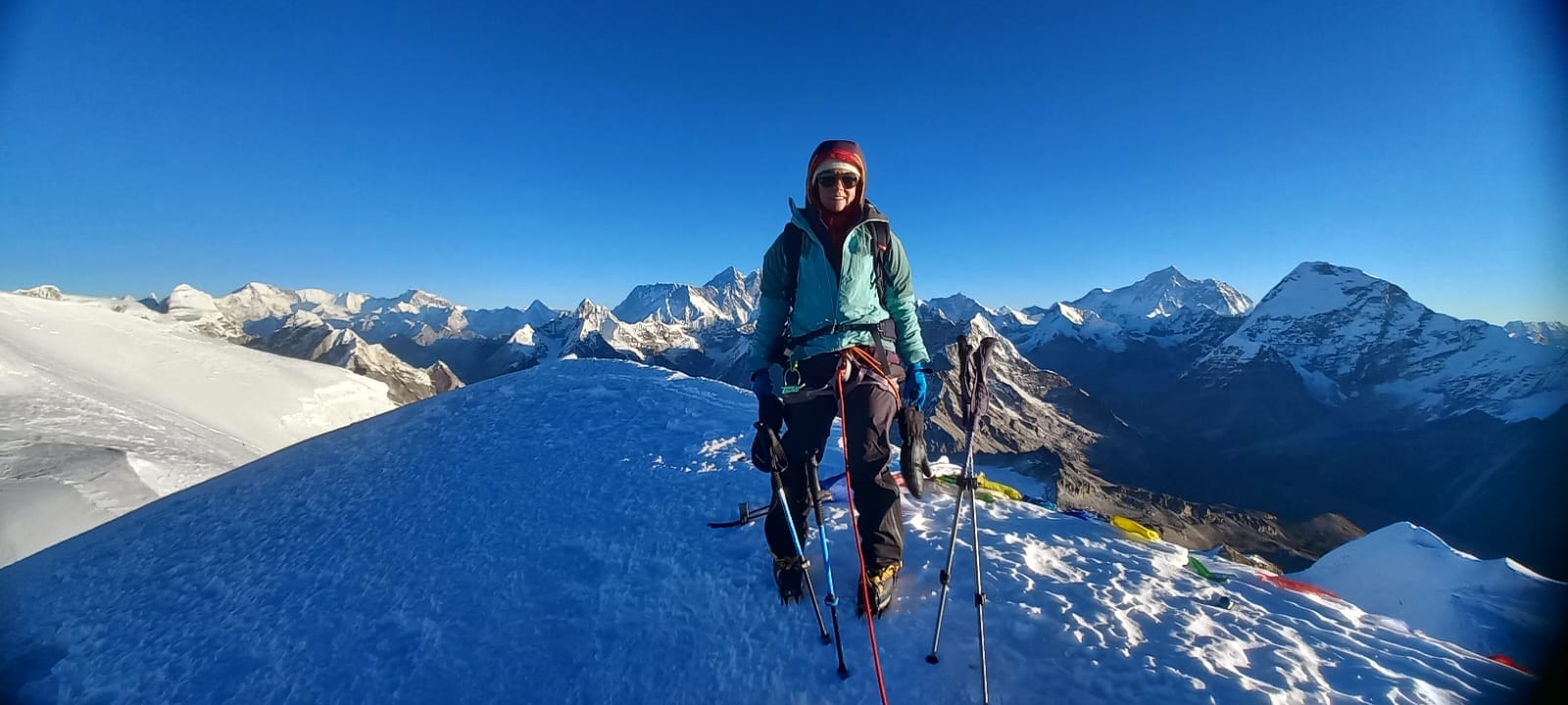
Three Peak Expedition
Embark on an unforgettable journey to the heart of the Himalayas as you conquer three majestic peaks: Mera Peak, Island Peak, and Lobuche Peak. This ultimate adventure combines technical climbing, bre...
Winter Camping on Lobuche Peak: Tips and Strategies
Winter camping on Lobuche Peak demands meticulous planning and preparation to withstand harsh Himalayan conditions. Choosing a sheltered campsite with natural windbreaks and stable snowpack is essential for minimizing exposure to high winds and avalanches. Setting up a robust tent, preferably a four-season expedition tent designed to withstand snow loading and provide insulation, ensures a comfortable and secure basecamp.
Insulating sleeping pads and sleeping bags rated for extreme cold temperatures, such as down-filled bags with waterproof shells, are crucial for retaining body heat during frigid nights. Layered clothing, including moisture-wicking base layers, insulating mid-layers, and waterproof outer shells, keeps climbers warm and dry throughout the day. Hot meals and warm beverages prepared on portable stoves maintain energy levels and morale in the cold mountain environment.
Regular equipment maintenance and monitoring weather forecasts ensure preparedness for changing conditions. Staying hydrated and protecting exposed skin from frostbite with sunscreen and lip balm are vital for health and well-being during winter camping on Lobuche Peak.
Staying Warm and Dry in Extreme Cold Conditions
Staying warm and dry in extreme cold conditions on Lobuche Peak requires a combination of proper clothing, equipment, and effective cold-weather strategies. Layering clothing is essential to regulate body temperature and manage moisture, starting with a moisture-wicking base layer, insulating mid-layer, and windproof and waterproof outer shell. Insulated gloves, a balaclava or neck gaiter, and thermal socks with mountaineering boots equipped with crampons ensure warmth and protection against frostbite.
Using a four-season expedition tent with a sturdy frame and snow skirts provides shelter from wind and snow accumulation, while insulating sleeping pads and sleeping bags rated for sub-zero temperatures offer comfort and warmth during overnight stays. Portable stoves for cooking hot meals and melting snow for drinking water maintain energy levels and hydration. Keeping clothing and gear dry by using waterproof stuff sacks and drying wet items inside the tent prevents hypothermia and promotes overall comfort in extreme cold conditions.
Dealing with Frostbite and Hypothermia on the Mountain
Dealing with frostbite and hypothermia on Lobuche Peak requires prompt recognition of symptoms and immediate treatment to prevent serious health risks. Frostbite affects exposed skin and extremities due to prolonged exposure to cold temperatures, causing numbness, discoloration, and tissue damage. Rewarming affected areas gradually using body heat or warm water, avoiding friction or rubbing, restores circulation and minimizes tissue damage.
Hypothermia occurs when the body loses heat faster than it can produce, leading to confusion, shivering, and loss of coordination. Preventing hypothermia involves wearing layered clothing, staying dry, and seeking shelter from wind and cold. Drinking warm fluids and consuming high-energy snacks maintain core body temperature and replenish energy stores during winter climbs.
Monitoring climbers for signs of frostbite and hypothermia, such as pale or waxy skin, confusion, or severe shivering, enables early intervention and emergency response planning. Carrying a comprehensive first aid kit with supplies for treating cold-related injuries and coordinating with emergency rescue services ensures swift and effective medical care in remote mountain environments.
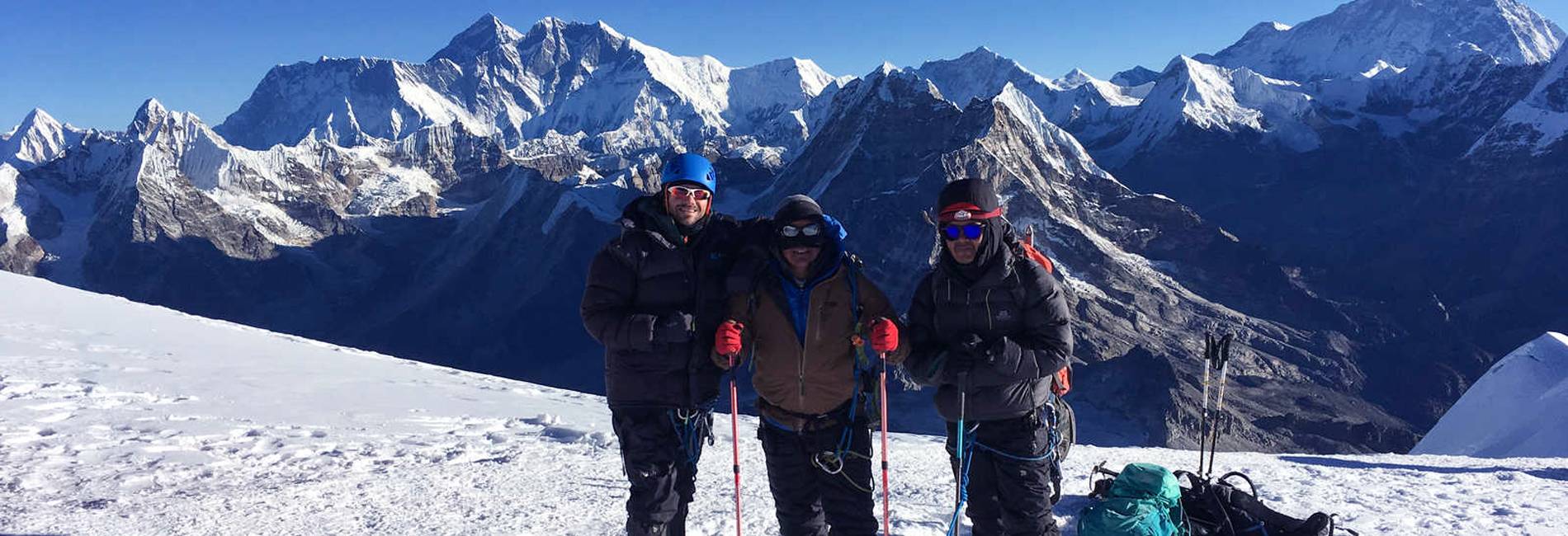
MERA PEAK CLIMBING
Mera Peak Climbing is an exhilarating adventure in Nepal that gives you an opportunity to reach the summit of Mera Peak at more than 6400m above sea level. Actually, it is the highest climbing (w...
Emergency Response Planning for Winter Climbing Accidents
Emergency response planning for winter climbing accidents on Lobuche Peak involves proactive risk assessment and preparedness to mitigate hazards and respond effectively to emergencies. Conducting a thorough pre-climb briefing with team members emphasizes safety protocols, communication strategies, and emergency contact information. Establishing designated meeting points and communication frequencies enhances coordination and ensures timely response to incidents.
Carrying essential rescue equipment, including ropes, harnesses, ice axes, and snow anchors, facilitates self-rescue and team rescue operations in challenging terrain. Practicing crevasse rescue techniques and scenario-based simulations prepares climbers to respond to accidents, such as falls or avalanches, with confidence and efficiency.
Developing an emergency action plan outlines roles and responsibilities for team members in the event of an accident, emphasizing the importance of prioritizing safety, assessing injuries, and providing first aid. Activating emergency communication devices, such as satellite phones or personal locator beacons, alerts rescue services and facilitates evacuation from remote mountain locations.
Collaborating with local guides, support staff, and emergency response agencies ensures access to timely medical care and evacuation services during winter climbing accidents on Lobuche Peak. Maintaining situational awareness and adapting response strategies to changing conditions promote safety and well-being in high-altitude environments.
Communication Strategies in Remote Winter Environments
Communication strategies in remote winter environments on Lobuche Peak are essential for maintaining safety, coordinating activities, and accessing assistance when needed. Reliable communication devices, such as satellite phones, two-way radios, or personal locator beacons (PLBs), enable real-time communication with team members, basecamp support, and emergency rescue services.
Establishing communication protocols, including check-in times, emergency codes, and location updates, enhances coordination and ensures accountability among climbers. Monitoring weather forecasts and sharing updates with team members inform decision-making and adapt plans to changing conditions during winter climbs.
Maintaining clear line-of-sight and avoiding obstacles that may obstruct signals optimize communication effectiveness in mountainous terrain. Using backup communication devices and carrying spare batteries or solar chargers mitigate risks of equipment failure and ensure continuous access to communication channels.
Training team members in effective communication techniques, including radio etiquette and emergency response procedures, promotes safety and efficiency during winter climbing expeditions on Lobuche Peak. Prioritizing clear and concise communication enhances situational awareness, fosters teamwork, and supports successful outcomes in remote and challenging environments.

ISLAND PEAK CLIMBING
Sherpa Expedition & Trekking (Est.1977) are pleased to announce FOR ADVENTURERS the most awesome, exhilarating & unforgettable climbing and treks on offer anywhere today!...
Lobuche Peak Climbing Itinerary for December: Day-by-Day Breakdown
Climbing Lobuche Peak in December requires a well-planned itinerary to navigate challenging terrain and variable weather conditions in Nepal's Everest region. Starting from Kathmandu, a scenic flight to Lukla initiates the journey, followed by a trek through picturesque Sherpa villages like Namche Bazaar and Tengboche. Acclimatization stops in Dingboche and Lobuche Base Camp prepare climbers for high-altitude challenges.
Day-by-day ascent includes gradual progression to High Camp, where climbers rest and acclimatize before the summit push. Summit day begins early, navigating icy slopes and crevassed terrain to reach Lobuche Peak's summit. Descent retraces the route back to Lobuche Base Camp, with overnight stops ensuring rest and recovery.
Flexible scheduling accommodates weather windows and ensures safety during winter climbs. Experienced guides facilitate logistics and provide support, optimizing climbers' chances for success while maintaining safety and environmental stewardship in the Himalayas.
Packing Essentials for Winter Climbing on Lobuche Peak
Packing essentials for winter climbing on Lobuche Peak ensures climbers are prepared for extreme cold, high altitude, and variable weather conditions. Clothing includes moisture-wicking base layers, insulating mid-layers, and waterproof outer shells to manage temperature and moisture. Insulated gloves, balaclava or neck gaiter, and thermal socks with mountaineering boots equipped with crampons protect against frostbite and maintain warmth.
Essential gear includes a four-season tent with snow skirts, sleeping bag rated for sub-zero temperatures, and insulated sleeping pad for comfort and insulation. Portable stove for cooking hot meals and melting snow for drinking water, along with high-energy snacks, sustains energy levels during climbs.
Navigation tools, including GPS device, detailed maps, and compass, ensure accurate route finding in remote and snow-covered terrain. Emergency equipment, such as first aid kit, headlamp with spare batteries, and communication devices like satellite phone or PLB, enhances safety and preparedness for unforeseen circumstances.
Winter Navigation Techniques: GPS, Maps, and Compass Use
Winter navigation techniques using GPS, maps, and compass are essential skills for safe and efficient climbing on Lobuche Peak in December. GPS devices provide precise location tracking and route planning, aiding navigation in snow-covered landscapes and variable weather conditions. Preloaded maps and digital waypoints facilitate real-time position updates and accurate route adjustments during climbs.
Traditional navigation with maps and compass enhances situational awareness and backup navigation capabilities in remote and mountainous terrain. Orienting maps to terrain features and magnetic north, using declination adjustments, ensures accurate direction finding and route verification. Compass navigation supports route planning, identifying landmarks, and maintaining course alignment during winter climbs on Lobuche Peak.
Combining GPS technology with traditional navigation skills optimizes safety and efficiency, promoting confident decision-making and effective route management in challenging winter conditions. Regular practice and familiarity with navigation tools prepare climbers for successful and rewarding expeditions on Lobuche Peak, emphasizing safety, environmental stewardship, and personal achievement in the Himalayas.

CHULU FAR EAST PEAK CLIMBING
Are you looking for adventure, natural beauty, magnificent snow-capped peaks, and unique cultural experience?This Peak Climbing will give you all the thrills, variety, and the adrenalin rush as you cl...
Environmental Impact of Winter Climbing on Lobuche Peak Ecosystems
Winter climbing on Lobuche Peak impacts fragile Himalayan ecosystems, requiring responsible practices to minimize environmental footprint and preserve natural habitats. Traveling on designated trails and established routes reduces soil erosion and disturbance to wildlife habitats, supporting biodiversity conservation.
Waste management practices, including packing out all non-biodegradable waste and disposing of human waste in designated facilities, prevent pollution and maintain pristine mountain environments. Minimizing campfire use and using portable stoves for cooking reduce deforestation and preserve natural fuel sources in remote areas.
Respecting local customs and cultural heritage, including sacred sites and traditional practices, fosters positive relationships with indigenous communities and promotes sustainable tourism. Supporting local businesses and employing eco-friendly practices, such as using renewable energy and reducing single-use plastics, contribute to sustainable development and environmental stewardship in the Everest region.
Educational initiatives, guided by experienced mountaineers and environmental experts, promote awareness of environmental issues and encourage responsible behavior among climbers. Advocating for conservation policies and participating in community-based initiatives strengthen efforts to protect and preserve the natural beauty and ecological integrity of Lobuche Peak and its surrounding ecosystems.
Conclusion: Tips for a Successful Lobuche Peak Climb in December
Climbing Lobuche Peak in December offers an exhilarating adventure amidst the pristine winter landscape of the Everest region, requiring careful preparation and adherence to safety protocols. Prioritize physical conditioning and acclimatization to high altitude, gradually increasing elevation gain to minimize risks of altitude sickness.
Pack essential gear and clothing suitable for extreme cold, including insulated layers, waterproof outerwear, and mountaineering boots with crampons. Maintain hydration and nutrition with hot meals and high-energy snacks, supporting endurance and performance during climbs.
Monitor weather forecasts and plan ascent and descent routes to optimize safety and navigation in changing winter conditions. Collaborate with experienced guides or join guided expeditions for support, local knowledge, and emergency response readiness.
Respect environmental conservation practices, minimizing impact on fragile ecosystems and cultural heritage sites. Leave no trace by packing out all waste and respecting wildlife habitats, contributing to sustainable tourism and community stewardship in the Everest region.
Celebrate achievements and cherish unforgettable moments on Lobuche Peak, embracing the challenges and rewards of winter climbing in one of the world's most spectacular mountain ranges.
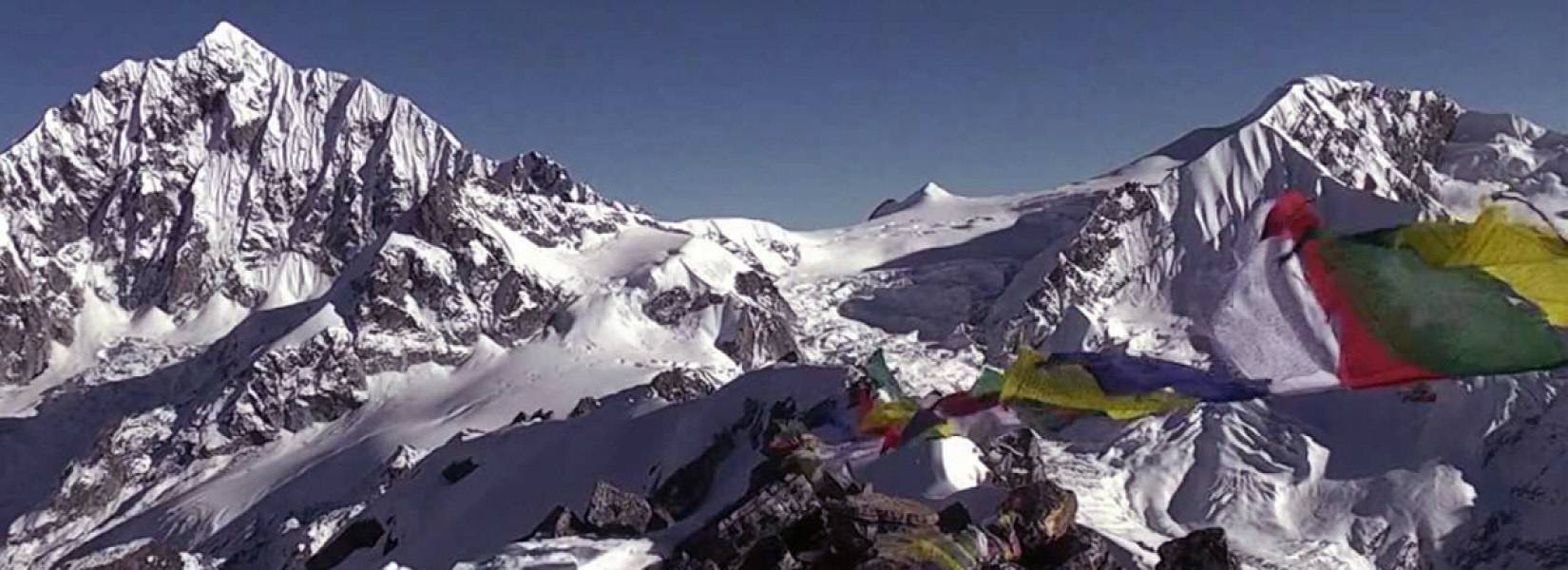
LARKE PEAK CLIMBING
Can there be any greater feeling than standing at the top of a mountain?This climb will test your endurance and determination and give you a true sense of achievement. The rewards are numerous. Firstl...
Lobuche Peak Climbing Packages
Lobuche Peak Summit Return By Helicopter
Lobuche Peak Expedition 14 Days
Any Questions? Let Us Know.
Recent Posts
17th June, 2025


















